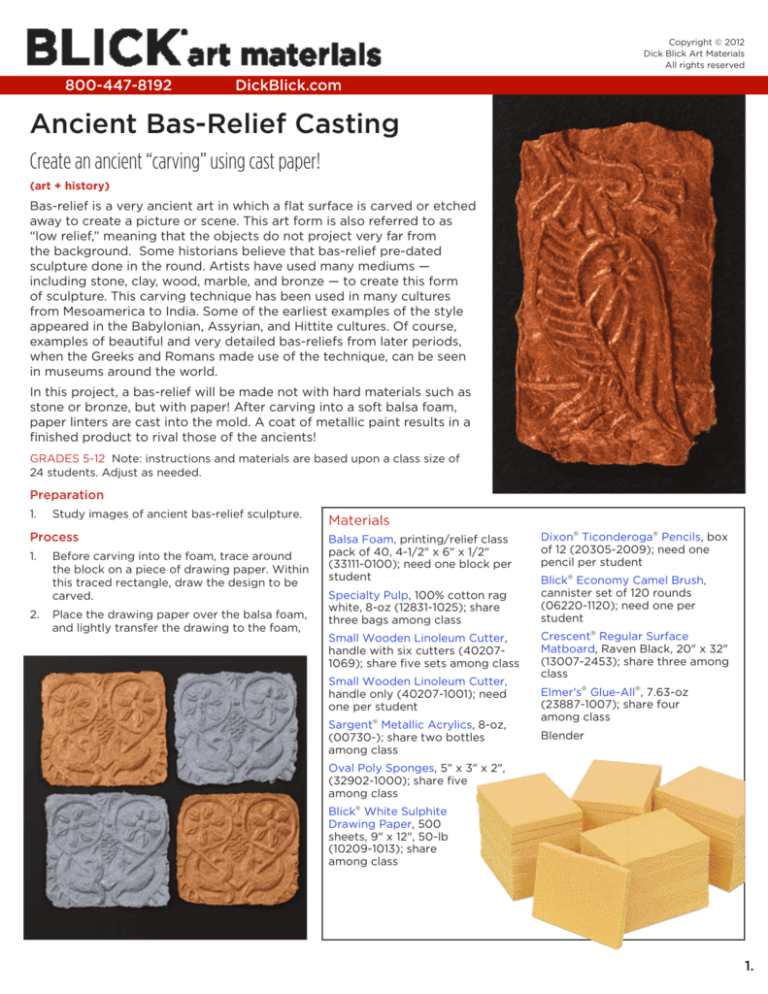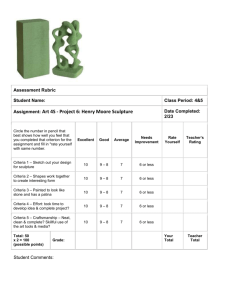
Copyright © 2012
Dick Blick Art Materials
All rights reserved
800-447-8192
DickBlick.com
Ancient Bas-Relief Casting
Create an ancient “carving” using cast paper!
(art + history)
Bas-relief is a very ancient art in which a flat surface is carved or etched
away to create a picture or scene. This art form is also referred to as
“low relief,” meaning that the objects do not project very far from
the background. Some historians believe that bas-relief pre-dated
sculpture done in the round. Artists have used many mediums —
including stone, clay, wood, marble, and bronze — to create this form
of sculpture. This carving technique has been used in many cultures
from Mesoamerica to India. Some of the earliest examples of the style
appeared in the Babylonian, Assyrian, and Hittite cultures. Of course,
examples of beautiful and very detailed bas-reliefs from later periods,
when the Greeks and Romans made use of the technique, can be seen
in museums around the world.
In this project, a bas-relief will be made not with hard materials such as
stone or bronze, but with paper! After carving into a soft balsa foam,
paper linters are cast into the mold. A coat of metallic paint results in a
finished product to rival those of the ancients!
GRADES 5-12 Note: instructions and materials are based upon a class size of
24 students. Adjust as needed.
Preparation
1.
Study images of ancient bas-relief sculpture.
Process
1.
Before carving into the foam, trace around
the block on a piece of drawing paper. Within
this traced rectangle, draw the design to be
carved.
2. Place the drawing paper over the balsa foam,
and lightly transfer the drawing to the foam,
Materials
Balsa Foam, printing/relief class
pack of 40, 4-1/2" x 6" x 1/2"
(33111-0100); need one block per
student
Specialty Pulp, 100% cotton rag
white, 8-oz (12831-1025); share
three bags among class
Small Wooden Linoleum Cutter,
handle with six cutters (402071069); share five sets among class
Small Wooden Linoleum Cutter,
handle only (40207-1001); need
one per student
Sargent® Metallic Acrylics, 8-oz,
(00730-); share two bottles
among class
Dixon® Ticonderoga® Pencils, box
of 12 (20305-2009); need one
pencil per student
Blick® Economy Camel Brush,
cannister set of 120 rounds
(06220-1120); need one per
student
Crescent® Regular Surface
Matboard, Raven Black, 20" x 32"
(13007-2453); share three among
class
Elmer’s® Glue-All®, 7.63-oz
(23887-1007); share four
among class
Blender
Oval Poly Sponges, 5" x 3" x 2",
(32902-1000); share five
among class
Blick® White Sulphite
Drawing Paper, 500
sheets, 9" x 12", 50-lb
(10209-1013); share
among class
1.
Process, continued
going over the drawing with a pencil (using light pressure).
The lines should be seen on the foam, and can be used as a
guide for the carving step. NOTE: Carving needs to be done in reverse: what is carved
away from the balsa foam will actually appear raised in the
final casting. The design will be opposite, like a mirror image.
3. Using linoleum cutters, carve down into the foam to create
a shallow relief. Since balsa foam is very soft, various tools
can also be used to compress the foam, in addition to the
carving. Save scraps of foam to experiment with different
types of techniques. Try pushing a pencil eraser into the
foam, or make lines with a pencil.
4. When the carving is complete, briefly rinse the foam under
running water to remove any dust that remains.
5. For paper casting, blend 1 cup of 100% White Cotton Rag
Pulp with 3 cups of water in a blender for 1-2 minutes. Pour
the pulp into a bowl, and gently pour off any water.
Step 1: Using a linoleum cutter and other tools,
carve a shallow relief design into the balsa foam.
6. Press the pulp into the balsa foam mold, distributing it to the
edges. Add enough pulp so that the finished casting will be
about 1/4" thick (make as many batches of pulp as needed).
Press as much water from the pulp as possible, using a
sponge to help draw the water out. Let dry completely,
preferably overnight.
7. When the casting is dry, paint it with bronze acrylic paint or
another metallic color, to mimic the look of cast metal.
8. Showcase the bas-relief sculpture by gluing it to a piece of
black matboard.
National Standards for Visual Arts Education
Content Standard #1 — Understanding and applying media,
techniques and processes
5-8 Students intentionally take advantage of the qualities and
characteristics of art media, techniques, and processes to
enhance communication of their experiences and ideas.
9-12 Students apply media, techniques, and processes with
sufficient skill, confidence, and sensitivity that their intentions are carried out in their artworks.
Step 2: Press the paper pulp into the balsa foam
mold to a depth of approximately 1/4" thick.
Content Standard #4 — Understanding the visual arts in relation to
history and cultures
5-8 Students describe and place a variety of art objects in
historical and cultural contexts.
9-12 Students describe the function and explore the meaning of
specific art objects within varied cultures, times, and places.
Step 3: When the paper casting is dry, brush on
metallic paint to mimic the look of cast metal.
800-447-8192
DickBlick.com
2.







